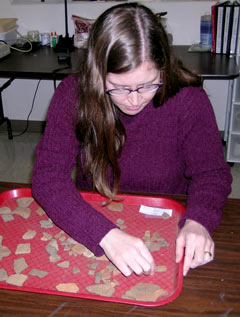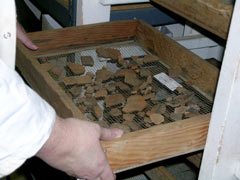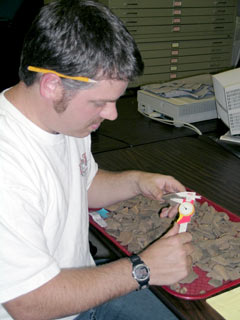- Home page
- What were you doing out there on Highway 61?
- Why did you dig there?
- Where is the site?
- Who lived there?
- What happens after the digging?
- What is archaeology?
- What is it like to work on a field crew?
- What is it like to work in the lab?
- Are there laws that protect archaeological sites?
- Ask a Native American about tribal history, archaeology, and more
- Who can I contact for more information?
- Special pages for students
- Special pages for teachers
- Special pages for archaeologists
Answering your questions
‘What happens after the digging?’
Archaeology is more than just digging. Once artifacts have been excavated the work has only just begun. When all the fieldwork is completed at the Leake Site, artifacts come to the laboratory to be studied and understood. The materials collected on site consist of artifacts such as ceramic vessel fragments and stone tools; and ecofacts such as animal bones, and plant remains such as seeds and nuts, and charcoal. For more information about artifact analysis in the Leake Site lab click here.
A lot of paperwork comes into the lab in addition to the artifacts. These records, consisting of field notes, hand drawn maps, and forms, along with all the other information collected out in the field, come together to create a total picture of the site. Many of the drawings will be turned into electronic maps and pictures that will help archaeologists determine what features may have been used for and in what order they may have been created. For more information about the creation of our electornic map click here.
Once the Principal Investigator archaeologist has all the pieces of the puzzle (results of analysis, special studies reports, maps, and photographs) it is up to him to write the story of the Leake Site. The resulting text, tables and charts are combined with the graphics and maps to create a detailed account of what was done on the site by archaeologists and what has been learned from the studies. In the past archaeologists actually pasted copies of photographs and drawings into the small number of hard copy reports printed or copied, but current technology in the way of publishing programs has enabled us to produce purely electronic copies of reports that can be sent around the world with a few keystrokes.



